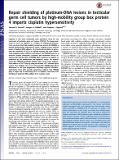Repair shielding of platinum-DNA lesions in testicular germ cell tumors by high-mobility group box protein 4 imparts cisplatin hypersensitivity
Author(s)
Awuah, Samuel; Riddell, Imogen Anne; Lippard, Stephen J.
DownloadAwuah-2017-Repair shielding of platinum-DNA le.pdf (1.115Mb)
PUBLISHER_POLICY
Publisher Policy
Article is made available in accordance with the publisher's policy and may be subject to US copyright law. Please refer to the publisher's site for terms of use.
Terms of use
Metadata
Show full item recordAbstract
Cisplatin is the most commonly used anticancer drug for the treatment of testicular germ cell tumors (TGCTs). The hypersensitivity of TGCTs to cisplatin is a subject of widespread interest. Here, we show that high-mobility group box protein 4 (HMGB4), a protein preferentially expressed in testes, uniquely blocks excision repair of cisplatin-DNA adducts, 1,2-intrastrand cross-links, to potentiate the sensitivity of TGCTs to cisplatin therapy. We used CRISPR/Cas9-mediated gene editing to knockout the HMGB4 gene in a testicular human embryonic carcinoma and examined cellular responses. We find that loss of HMGB4 elicits resistance to cisplatin as evidenced by cell proliferation and apoptosis assays. We demonstrate that HMGB4 specifically inhibits repair of the major cisplatin-DNA adducts in TGCT cells by using the human TGCT excision repair system. Our findings also reveal characteristic HMGB4-dependent differences in cell cycle progression following cisplatin treatment. Collectively, these data provide convincing evidence that HMGB4 plays a major role in sensitizing TGCTs to cisplatin, consistent with shielding of platinum-DNA adducts from excision repair.
Date issued
2017-01Department
Massachusetts Institute of Technology. Department of Chemistry; Koch Institute for Integrative Cancer Research at MITJournal
Proceedings of the National Academy of Sciences
Publisher
National Academy of Sciences (U.S.)
Citation
Awuah, Samuel G. et al. “Repair Shielding of Platinum-DNA Lesions in Testicular Germ Cell Tumors by High-Mobility Group Box Protein 4 Imparts Cisplatin Hypersensitivity.” Proceedings of the National Academy of Sciences 114, 5 (January 2017): 950–955 © 2017 National Academy of Sciences
Version: Final published version
ISSN
0027-8424
1091-6490